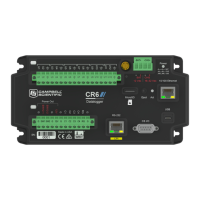The actual f
N1
may deviate from the user-specified setting since a whole integer number of
samples must be averaged. For example, if fN1 is set to 60 Hz, 1563 samples (93750 / 60 =
1562.5) will be averaged to produce the filtered result. The rounding of 1562.5 to 1563 moves the
actual f
N1
to 93750 / 1563 = 59.98 Hz.
9.10.6 Minimizing settling errors
Settling time allows an analog voltage signal to rise or fall closer to its true magnitude prior to
measurement. Default settling times, those resulting when the SettlingTime parameter is set
to 0, provide sufficient settling in most cases. Additional settling time is often programmed when
measuring high-resistance (high-impedance) sensors, or when sensors connect to the input
terminals by long cables. The time to complete a measurement increases with increasing settling
time. For example, a 1 ms increase in settling time for a bridge instruction with input reversal and
excitation reversal results in a 4 ms increase in time to perform the instruction.
When sensors require long cable lengths, use the following general practices to minimize settling
errors:
l Do not use leads with PVC-insulated conductors. PVC has a high dielectric constant, which
extends input settling time.
l Where possible, run excitation leads and signal leads in separate shields to minimize
transients.
l When measurement speed is not a prime consideration, additional time can be used to
ensure ample settling time.
l In difficult cases where measurement speed is a consideration, an appropriate settling time
can be determined through testing.
9.10.6.1 Measuring settling time
Settling time for a particular sensor and cable can be measured with the CR6. Programming a
series of measurements with increasing settling times will yield data that indicate at what settling
time a further increase results in negligible change in the measured voltage. The programmed
settling time at this point indicates the settling time needed for the sensor / cable combination.
The following CRBasic Example: Measuring Settling Time presents CRBasic code to help
determine settling time for a pressure transducer using a high-capacitance semiconductor. The
code consists of a series of full-bridge measurements (BrFull()) with increasing settling times.
The pressure transducer is placed in steady-state conditions so changes in measured voltage are
attributable to settling time rather than changes in pressure.
9. Tips and troubleshooting 153

